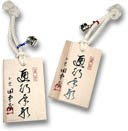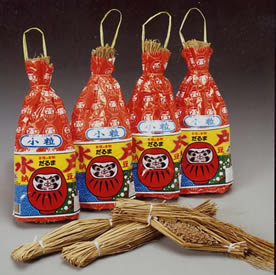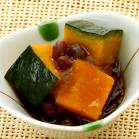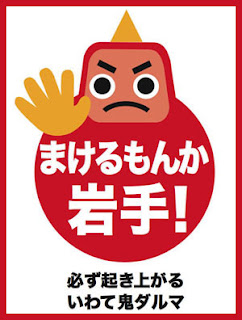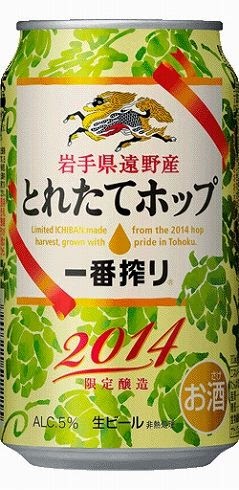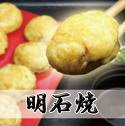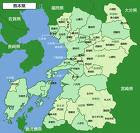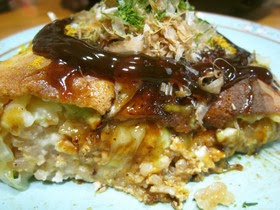::::::::::::::::::::::::::::::::::::::::::::::::::::::::::::::::::::::::::::::::::::::::::::::::::::
Ishikawa (Kaga)
Including Wajima, Noto Peninsula, some islands, including Notojima, Mitsukejima, Hegurajima. Wajima is famous for its laquer ware.
Lackarbeiten aus Wajima.
Ishikawa Prefecture (石川県, Ishikawa-ken) is a prefecture of Japan located in the Chūbu region on Honshū island. The capital is Kanazawa 金沢.
Nō (Noh) was introduced to the area during the rule of the fifth Maeda lord Tsunanori and was refined into the Kaga hosho style.
The tea ceremony arrived in 1666 when Maeda Toshitsune invited Senbiki Soshitsu of urasenke to Kanazawa.
Kutani porcelain (Kutani yaki), bright colored glazes not unlike Chinese porcelain.
Ohi teaware (Ōhi yaki), a pottery style unique to Kanazawa.
Kaga silk (Kaga yūzen), a complicated silk print technique with an intentional rough look (wabi-sabi).
Kanazawa lacquerware (Kanazawa shikki), high quality lacquerware traditionally decorated with gold dust.
Kanazawa gold leaf (Kanazawa haku), a technique of beating gold into wafer-thin sheets.
Kaga mizuhiki, ribbon-like decorations made from glued Japanese paper (washi).
Kaga inlay crafts (Kaga zōgan), a combination of thin flat and thread metal inlays.
© More in the WIKIPEDIA !
oomichoo ichiba 近江町市場 Omi-cho Market
the old Kaga domain 加賀
:::::::::::::::::::::::::::::::::::::::::::::::::::::::::::::::::::::::::::::::::::::::::::::::::::::
Special dishes from Ishikawa
quote
Since ancient times, the human race has benefited from microorganisms by creating various fermented foods. Japan has internationally well known fermented foods such as soy sauce and miso, sake, dried bonito and natto, but it seems that with its hot, humid summers and cold winters, Ishikawa Prefecture has a climate that is particularly suited to fermentation. And indeed, there are many fermented foods in Ishikawa as well.
see below
Narezushi
Ishiri/Ishiru
Kabura-zushi/Daikon-zushi
Konka-zuke (fish pickled in rice-bran paste)
source : shofu.pref.ishikawa.jp
akashia hachimitsu アカシアはちみつ acacia honey
amaebi 甘えび sweet shrimp
. . . . . gasuebi, gasu-ebi , Echizen amaebi, ama-ebi 越前甘えび / がすえび/ がす海老
Grilled with salt as shioyaki.
. . . CLICK here for Photos !
but
Echizen (越前国, Echizen no kuni) was an old province of Japan, which is today the northern part of Fukui prefecture.
azami no uchimame jiru あざみの打ち豆汁 soup with thistles
:::::::::::::::::::::::::::::::::::::::::::::::::::::::::::::::::::::::::::::::::::::::::::::::::::::
WASHOKU
FU 麩 Wheat glutene preparations
breadlike pieces of dried wheat gluten
necessary for the Kaga cuisine. sudarebu
Fu-Croutons, aus Weizenmehl.
Enthalten Weizengluten
:::::::::::::::::::::::::::::::::::::::::::::::::::::::::::::::::::::::::::::::::::::::::::::::::::::
fugu no ranso no nukazuke ふぐの卵巣の糠漬け roe of fugu fish ovaries with eggs pickled in ricebran
The ovaries are poisonous. They are first pickled in salt for one year, then in komenuka ricebran from the area for another year, while some iwashi-dashi is poored into the barrels to give it better taste. This dissolves the poison and makes it a delicous topping for rice. Some families keep the proud tradition as a kind of "World Heritage".
. . . CLICK here for Photos !
gori no tsukudani ごりの佃煮 tsukudani of gori fish
Cottus pollux. (kajika). Japanese sculpin
. . . CLICK here for Photos !
Kaulkopf.
hachiku no nimono はちく(淡竹)の煮物
special boiled bamoo dish
hamairi, hamayude, hama-iri 浜いり / 浜ゆで "fish boiled at the beach"
Boiled simply in salt water, but this brings the taste of the fish to ist best.
hawasabi no sennazuke 葉わさびのせんな漬け
pickles with leaf wasabi Japanese horseradish
:::::::::::::::::::::::::::::::::::::::::::::::::::::::::::::::::::::::::::::::::::::::::::::::::::::
ishiri ryoori いしり料理 dishes with a special fish sauce
Ishiri is made from fermented squid liver and salt. This preparation has antioxidant properties and is very healthy.
. . . CLICK here for Photos !
quote
“Ishiri”, or “ishiru”いしる料理, which has been made on the Noto Peninsula since ancient times, is one of Japan’s most well known fish sauces. It is made from squid entrails or sardines. Alternating layers of fish and salt are placed in a barrel, and left to ferment for one to two years. The liquid produced this way is used to flavor soups and boiled dishes. Despite the fact that a lot of salt is used, the flavor is sweeter than it is salty. This is because a lot of amino acid is produced during the fermentation process. The sauce contains balanced amounts of glutamic acid, which produces good flavor, asparaginic acid, which produces acidity, and alanine, which produce sweetness, as well as lysine and arginine, which produce bitterness. All of these elements combine to give the sauce a sophisticated taste. Because it also contains the antioxidant taurine and lowers blood pressure, it is attracting attention as a health food.
source : shofu.pref.ishikawa.jp
:::::::::::::::::::::::::::::::::::::::::::::::::::::::::::::::::::::::::::::::::::::::::::::::::::::
iwashi no tamago no hana sushi いわしの卯の花寿司
jibuni じぶ煮(冶部煮)boiled duck meat
. . . CLICK here for Photos !
The name comes from the sound "jibu jibu", when a different tasty broth is cooked for each ingredient. Preparing with different broths (shitagoshirae) is important.
A special kind of FU is also used, sudarebu すだれ麩. FU is a kind of gluten croutons, which here in Kaga is of a long rectangular form.
. . . CLICK here for Photos of "sudarebu" !
The final toromi with a bit of wheat flour for the broth is important.
Jibuni is served in a special jibuni wan, laquer bowl, which is rather flat to show the different ingredients.
Another source says there was a samurai Okabe Jibuemon 岡部治右衛門(じぶえもん) who invented this dish.
http://www.ajinomoto.co.jp/recipe/condition/menu/704421.asp
haiku see below
kigo for all winter
kagami mochi 鏡餅 "mirror mochi" for the new year
in red and white, koohaku, for extra good luck
CLICK here for PHOTOS !
Kaga ryoori, Kaga ryori 加賀料理 dishes from Kaga
. . . CLICK here for Photos !
Kaga renkon ryoori 加賀れんこんの料理 with lotus root
Kaga yasai ryoori 加賀野菜料理 vegetable dishes from Kaga
Kaga ryori is also famous for the Kutani plates and pots used. Motenashi no kokoro.
See below for MORE.
kaki no hazushi, sushi 柿の葉ずし sushi with persimmon leaves
kamameshi 釜飯 rice cooked in a kama bowl
kamo no jibusuki 鴨のじぶすき hodgepodge with duck meat
:::::::::::::::::::::::::::::::::::::::::::::::::::::::::::::::::::::::::::::::::::::::::::::::::::::
konka-zuke こんか漬け /こんかづけ fish pickled in rice-bran paste
. . . CLICK here for Photos !
quote
Pickling in rice-bran paste is one of the ways of preserving fish that developed in Japan, an island country with plentiful fish. This dish is made in almost every area on the Japan Sea coast, and it has many different names. In Ishikawa Prefecture it is usually called “konka-zuke”. The fish used include sardines, herring, mackerel and blowfish. The head and entrails of large fish are removed, and the fish are cut into three fillets. Small fish are salted and then pickled in rice-bran paste as they are. Blowfish are soaked in salted water, dried, and then pickled in rice-bran paste. In Ishikawa Prefecture rice malt is often added for flavor.
source : shofu.pref.ishikawa.jp
:::::::::::::::::::::::::::::::::::::::::::::::::::::::::::::::::::::::::::::::::::::::::::::::::::::
korogaki ころ柿 dried persimmons
matsutake マツタケ / まつたけ/ 松茸 matsutake mushrooms
Tricholoma matsutake
one of the most expensive mushrooms of Japan.
prepared as dobinmushi and other delicacies
. . . CLICK here for Photos !
Kiefernpilz
:::::::::::::::::::::::::::::::::::::::::::::::::::::::::::::::::::::::::::::::::::::::::::::::::::::
narezushi なれ寿司(鮨)
hinezushi
. . . CLICK here for Photos !
quote
“Narezushi” is made by salting fish, pickling it with rice, and then pressing it while it undergoes lactic acid fermentation. It is a food that represents the deep connection between Southeast Asian and Japanese food culture. In the Noto region of Ishikawa it is called “narezushi”. The fish used range from river fish such as dace and sweetfish, to saltwater fish such as horse mackerel, mackerel, hachime, salmon and small sea bream. People in each region use the fish that is most familiar to them. The head and entrails are removed from small fish, and large fish are cut into fillets. After 40–50 days of pickling, the flavor is absorbed, and the bones are soft. In some households vegetables are pickled together with the fish.
source : shofu.pref.ishikawa.jp
http://www.jetro.org/trends/food_recipe.php
:::::::::::::::::::::::::::::::::::::::::::::::::::::::::::::::::::::::::::::::::::::::::::::::::::::
Noto no kaki ryoori 能登のかき料理 oysters from the Noto peninsula
Rusk / 金沢金箔ラスク Kanazawa Kinpaku Rasuku (rusk) bread with cold foil
sazae ryoori さざえ料理 dishes with sazae conches
Suzu Salt 能登すず塩
This mineral-rich sea salt comes from the Japan Sea at the edge of Ishikawa´s Noto peninsula where the people of Suzu have been preparing it by hand for over 500 years. This handcrafted salt has a soft, luxurious flavor, and with its slightly sweet flavor, it is the perfect complement for sashimi, tempura or fried and grilled dishes. Suzu salt is also an excellent addition to soups, dressings and sauces in both western and Japanese preparations.The Japanese government officially recognizes traditionally prepared Suzu salt is as an 'intangible cultural product' of Japan. source : www.jetro.org
tai no karamushi 鯛の唐蒸し steamed sea bream
Speciality of Kaga ryoori
. . . CLICK here for Photos !
:::::::::::::::::::::::::::::::::::::::::::::::::::::::::::::::::::::::::::::::::::::::::::::::::::
Kaga Ryori : (加賀料理)
Kaga cuisine, Küche aus Kaga
The mountains, hills, plains, rivers, lagoons, dunes, Sea of Japan and other sources of abundant nature in its purest form bring their rich ingredients to Kanazawa and her people. They have also, over the centuries, led to the refined sophistication that is the modern day cuisine of Kanazawa.
Kabura-zushi (salted yellowtail sandwiched between turnips), jibu-ni (stewed duck with vegetables) and tai-no-karamushi (steamed sea bream with vegetables) are worthy of special mention but to round off the satisfaction of the palate, the satisfaction of the eyes is oftentimes enhanced as such local dishes are usually served on locally produced Kutani porcelain and lacquerware.
www.att-japan.net
The most famous place is Otomo-Ro, Ootomo roo 大友楼
founded 180 years ago, The Otomo family has been the appointed cook for the Maeda daimyo.
The present owner is Otomo Satoshi 大友佐俊 (おおとも さとし)a direct descendant in the 7th generation.
Satoshi was once been invited to Vienna (Wien) to cook for the descendant of the Habsburg Queen Maria Theresia, Gräfin Camilla Habsburg, on November 2, 2007. He took two of his best cooks and the three produced Kaga Cuisine with the ingredients they could get in Vienna. He took with him a very precious laquer box which the Maeda Daimyo had used on outings. The other dishes were served on the famous AUGARTEN porcelain from the Habsburg Musuem, which lend them for this occasion. They served 11 different dishes, including a desert to go with coffee.
They used the kitchen of the private castle Schloss Seisenegg of friends of the Habsburg family and had to carry all the dishes through the corridors of the castle to the guests in the dining room. Satoshi waited on the guests and explained the Kaga food, which the 3 Europeans (Herr und Frau Seisenegg und Camilla) had to eat with chopsticks.
Kaiserkoch Satoshi Otomo, as he is called in a local German newspaper clip.
加賀百万石の「殿様の料理番」がウィーンの古城でハプスブルク家の子孫に豪華絢爛な料理絵巻で挑む料理
On Japanese TV in a 2 hour special probram.
Jibuni
One of Kanazawa’s signature dishes, Jibuni has been a traditional meal in Ishikawa for generations. In Japan, Jibuni is often prepared at the table while guests drink beer or sake and talk before serving themselves from the communal pot. This is somewhat similar to other hot-pot (nabe) style dishes, but the cooking method is somewhat unconventional even within Japan. Jibuni begins with a starch-battered duck that is chopped, bound, and steamed. This is then added to the seasoned bonito broth along with several regional vegetables and brought to a boil. As with most of Kaga cuisine’s specialty dishes, Jibuni is known for more than its savory and layered flavors and is meant to appeal to the nose and the eyes as well as to the taste buds.
ISHIRI いしり
. . . CLICK here for Photos !
(see also above)
is a kind of soy sauce made with fish parts 魚醤油 at the Oku Noto peninsula 能登半島 and used for traditional dishes of this area. The liver of surume ika スルメイカ, iwashi sardines caught in the Tsushima Kairyuu 対馬海流 sea current are used. This sauce is also called 「いしる ishiru」、「よしり yoshiri」、「よしる yoshiru」、「塩しり shioshiri」、「塩しる shioshiru」.
And old pronounciatio of the word for fish was YO ヨ or IO いお.
shiri derived from shiru 汁, liquid.
Fish was also called I, as in the place name for the river Itoigawa 糸魚川(イトイガワ).
In Oku Noto 奥能登地方, vegetable soup is called najiri 菜汁(ナジリ).
In the Noto peninsula, a lot of salt is also produced since olden times.
There is also Ishiri Ponzu.
WASHOKU : Soy Sauce , Sojasoße, Sojasauce 醤油
Kaga vegetables 加賀野菜 Kaga yasai
Vegetables from Ishikawa prefecture
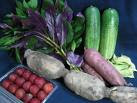
15 types of vegetables have been grown in the area since 1945 and before. They grow in the Kaga plain and have the good water of Mount Hakusan.
aka kabocha 赤かぼちゃ. 赤皮甘栗南瓜 red-skinned pumpkin
Utsugi akagaw amakuri kabocha
打木赤皮甘栗かぼちゃ(うつぎ・あかがわあまぐり‐)
. . . CLICK here for Photos !
roter Hokkaidokürbis aus Kaga
akazuiki 赤ずいき red taro stems
. . . CLICK here for Photos !
Gensuke daikon 源助大根(げんすけだいこん) Big Radish
A special variety grown first by Inoue Gensuke 井上源助.
Gorojima kintoki 五郎島金時 sweet potatos from Gorojima Town
. . . CLICK here for Photos !
It has less fiber than other varieties of Japan and is sweeter. Used to make monburan モンブラン sweet cakes from August to November.
Futazuka karashina 二塚からしな(ふたつか‐)
karashina "mustard leaf" from Futatsuka
Brassica juncea, Senfkraut.
heta murasaki nasu ヘタ紫なす violet eggplants
eggplants, "green to the stem". also called
marunasu 丸なす "round eggplants"
Kaga futo kyuuri 加賀太ぎゅうり(かが・ふと‐)
thick cucumbers from Kaga
Kaga tsurumame 加賀つるまめ green beans
Stangenbohne, Phaseolus vulgaris
Kanazawa ippon futonegi 金沢一本太ねぎ
thick leek from Kanazawa
dickre Lauch aus Kanazawa
Kanazawa shungiku 金沢春菊
Mutterkraut aus Kanazawa. From October to April.
Chrysanthemum coronarium
kinjiso, kinjisoo 金時草(きんじそう)
Gynura bicolor . Kinjisoo-Blattgemuese
It has zigzagshaped leaves and the color of the front is green, where as the backside is a sparkling "kintoki 金時" bright red-violett color. Hence the name, which resembles the kintoki sasage 金時ささげ mame, red-violett beans.
Kinjiso is rich in vitamins a, B1, B2, calium, iron, calcium and others.
. . . CLICK here for Photos !
kuwai くわい arrowhead
Sagittaria trifolia. Pfeilkraut
maruimo, maru-imo, 丸いも round yam root
Dioscorea japonica
„Runde Jamswurzel“
renkon, Kaga renkon 加賀レンコン/ 加賀れんこん
Lotos roots from Kaga
Lotus aus Kaga
satsumaimo , satsuma imo さつまいも sweet potatos
seri セリ, せり, 芹
Brunnenkresse. Japanische Petersilie. Oenanthe javanica
takenoko たけのこ bamboo shoots
From April to May.
Other traditional vegetables
aoshima uri, kata uri 青シマ瓜(かた瓜)
... mino uri みの瓜
... nashi uri, ama uri なし瓜(あま瓜)
gourds
Dentooji satoimo 伝灯寺里芋 sato imo from temple Dentoji
Kaga hakusai 加賀白菜 chinese cabbage from Kaga
Kaga fushinari kyuuri 加賀節成きゅうり(かが・ふしなり‐)
cucumbers from Kaga
Mitani akigyuuri 三谷秋胡瓜(みたに・あきぎゅうり)
autumn cucumbers from Mitani
Tsurugisaki 剣崎辛長なんば
::::::::::::::::::::::::::::::::::::::::::::::
seafood from Kaga
crabs are eaten from November onward.
zuwaigani, male snow crabs. female crabs, which are half the size, are called "kobakogani" こばこ蟹.
kani no koorayaki 蟹甲羅焼き
buri 鰤 yellowtail
buri daikon ぶり大根 yellowtail with radish
. . . CLICK here for Photos of BURI DAIKON !
buri no tataki 鰤たたき
buri no shioyaki 鰤塩焼き
::::::::::::::::::::::::::::::::::::::::::::::
kaburazushi, kabura-zushi カブラ寿司, 蕪ずし]
salted yellowtail sandwiched between turnips
The most representative food in winter in Kanazawa. The name is SUSHI, but it is a sort of pickled food and special taste for every home. Thick slices of salted turnips are cut open and a slice of salted yellowtail is sandwiched inbetween. The whole is marinated in rice and rice malt. It is prepared to be eaten about 2 weeks after the preparation, so it can ferment to the proper taste. Essential for the New Year food.
Fermentierte Rüben und Gelbschwanz
. . . CLICK here for Photos !
quote
“Kabura-zushi” and “daikon-zushi” are representative winter foods of the Kaga region of Ishikawa Prefecture, derived from “narezushi” . “Kabura-zushi” is made by cutting turnip into round slices, which are pickled in salt. Salted yellowtail fillets are sandwiched between the pickled turnip slices, and pickled with a mixture of rice and rice malt. “Daikon-zushi” is made from daikon radish and re-hydrated dried herring. The fermentation process is affected by the temperature, and by the amount of pickling salt used, so it is difficult to judge the length of time for pickling. The acidity produced by lactic acid fermentation and the mild sweetness of the rice malt, combined with the flavor of the fish, make this dish popular as an accompaniment to sake.
source : shofu.pref.ishikawa.jp
::::::::::::::::::::::::::::::::::::::::::::::::::::::::::::::::::::::::::::::::::::::::::::::::::::
:::::::::::::::::::::::::::::::::::::::::::::::::::::::::::::::::::::::::::::::::::::::::::::::::::::
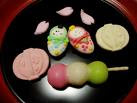
Kanazawa no Wagashi 金沢に和菓子
Tea sweets from Kanazawa, Japanese confections
The tea ceremony has old roots in Kanazawa. The expressions of the four seasons are rooted deep with the people. Not only the taste, but the seasonal look of the sweets is attractive. The tradition has been supported by "sweets craftsmen" for a long time. It is part of the culture of Kanazawa.
The tea ceremony and with it the wagashi sweets, has flourished in Kyoto, Matsue (Shimane) and Kanazawa.
The first daimyo, Maeda Toshiie 前田利家 (1538―99), was a close friend of Hideyoshi and had experienced the tea ceremony with him. His eldest son, Maeda Toshinaga 前田利長 (1562―1614) had studied TEA with the great tea master Sen no Rikyu 千利休. The third daimyo of the Maeda clan, Toshitsune 利常, studied TEA with master Kobori Enshu 小堀遠州 and Sensoosen Sooshitsu 仙叟千宗室(せんそうせんのそうしつ). The fifth daimyo was also involved in TEA,especially the collection of tea untenils (cha doogu 道茶具).
Therefore even the normal people of the town of Kanazawa learned about tea and its importance in Japanese culture.
Japanese sweets are made with images of seasonal natural features from raw materials, such as rice, red beans and wasanbon sugar from Shikoku.
The first tea sweets were made when Toshiie came to Kanazawa in 1590. Then he appointed a sweet maker for his castle, 堂後屋三郎衛門. Another appointed sweet maker, 樫田吉蔵, was the first to came up with the idea of making sweets in five colors (goshiki namagashi)五色生菓子 in 1600, when princess Tamahime 珠姫 (second daughter of Tokugawa Hidetada) came as bride for his younger brother Toshitsune to Kanazawa.
White riceflower manjuu with sweet bean paste are colored red to represent the rising sun. Brown Sesame cover is the moon behind the clouds. Diamond-shaped manjuu represent the waves of the sea. Yellow grains are the full moon in its splendor. Red bean paste on the outside of a cake represent the land and country side with the farmers.
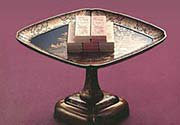
In 1630 Toshitsune had ordered to make some dry sweets (higashi) rakugan with the decorative inscripton of the name of Chooseiden (choseiden) 長生殿
wirtten by famous calligrafer Kobori Enshu.
They are now one of the three most famous sweets of Japan!
. . . CLICK here for Photos !
The people of Kanazawa were also very pious and there are many temples in town. The sweets of the daimyo were soon used for religious ceremonies too and thus among the common people. Especially rakugan dry sweets, Manjuu and Mochi were favorites.
There are sweets for all seasons and all seasonal religious festivals

tsuji uranai, Fortune Cookies
for the new year fuku-ume 福梅and tsuji uranai 辻占
. . . CLICK here for FUKU UME Photos !
Fuku-ume, the "Auspicious plum" comes as a wafer in red and white. Tee plum blossom is in the family crest of the Maeda clan. This is eaten for the New Year.

for Dolls festival. kinkatoo 金花糖
(forms of fish like tai and koi made of sugar)
„Goldener Blumen-Zucker“
in summer 氷室饅頭 himuro "ice cellar manjuu"
Eaten on the first day of the 7th month (himuro no tsuitachi)
They are of white and red color and eaten with the wish for good health during the following year. Made from barley flower. In Kaga it was custom to open the ice cellars (himuro) on the first day of the 6th month (now June 30). The ice, which was collected in winter from pure wter ponds, was put on carts and transported hastily to the Shogun in Edo.
. . . CLICK here for Photos !
for Star festival. sasagemochi ささげ餅 with beans
. . . CLICK here for Photos !
sweets for all family celebrations
to pray for a save childbirth ころころ団子 korokoro dango
. . . CLICK here for korokoro dango Photos !
to pray for the birth of a boy 杵巻き and kinchaku mochi 巾着餅
for a marriage ceremony 五色生菓子 "raw sweets in five colors"
sweets in five varieties
. . . CLICK here for "Five Colored Sweets" Photos !
sweets for temples and shrines 寺社菓子
sweets for good luck 縁起菓子
. . . CLICK here for "good luck sweets" Photos !
sweets for celebrations 祝い菓子
. . . CLICK here for "celebration sweets" Photos !
sweets for the changing of seasons 四季折々の菓子
chitose 千歳(ちとせ)"Ten thousand years"
This sweet-bean dumpling is wrapped in a dough with rice flour and pink and white sugar, which is transparent, representing the glow of sunrise and snow on Mount Fuji.
Daruma Museum
Fukutoku Senbei 福徳せんべい Lucky Waffles
sugar used for the Kanazawa sweets
wasanbon 和三盆 Japanese sugar from Shikoku
Japanischer Zucker
:::::::::::::::::::::::::::::::::::::::::::::::::::::::::::::::::::::::::::::::::::::::::::::::::::::

Otome no Kanazawa
Book about cafes, sweets and more
(and a Daruma on the cover ! )

source : 乙女の金沢
Online References
*****************************
Worldwide use
*****************************
Things found on the way
Shichirin 七輪 portable cooking stove
kiridashi shichirin 切り出し七輪 from the Noto peninsula 能登
are cut out of one piece of earth. They come in round or oblong forms for sanma fish.
. . . CLICK here for Photos of Noto Shichirin !
:::::::::::::::::::::::::::::::::::::::::::::::::::::::::::::::::::::::::::::::::::::::::::::::::::::
kigo for early summer
Hyakumangoku Matsuri 金沢百万石まつり
Hyakumangoku Festival
Oyama matsuri 尾山祭(おやままつり)Oyama Shrine Festival
hyakumangoku gyooretsu 百万石行列(ひゃくまんごくぎょうれつ)
hookoku matsuri 封国祭(ほうこくまつり)"land presenting festival"
(Lord Maeda gave land to his retainers to govern.)
June 13 to 15
Main Festival at the shrine Oyama Jinja 尾山神社 .
. . . CLICK here for Photos of the Shrine !

Held on the first Sunday in June in memory of the entry of the daimyo Maeda Toshiie to Kanazawa Castle in 1583.
The main event is the splendid Hakumangoku Gyoretsu, a long procession of people dressed in samurai costumes. The parade walks around the area between Kanazawa Station and Kanazawa Castle Park.
http://www.100mangoku.net/
- quote -
Oyama Shrine (尾山神社, Oyama Jinja) is dedicated to Maeda Toshiie, the first lord of the powerful, local Maeda Clan. The shrine was constructed in 1599 by Toshiie's successor, Maeda Toshinaga on Mount Utatsu. It was later moved to its present location.
Oyama Shrine is known for its unusual gate, which was designed by a Dutch architect, using elements of European and Asian religious themes. While the first story displays a mixture of Japanese and Chinese influence, the upper stories once served as a lighthouse and feature a Dutch style, stained glass window.

The gate originally guarded the entrance to the palace of Kanazawa Castle, and was only later moved to Oyama Shrine. On the shrine grounds stands a statue of Lord Toshiie. There is also a nice strolling garden with ponds and bridges, designed to resemble harps and lutes.
- source : japan-guide.com -
- Homepage of the shrine
金沢市尾山町11-1
- source : oyama-jinja.or.jp -
. Kanazawa no kachi kabuto 金沢のかち兜 / 勝兜 winning helmet .
in memory of the entry of the daimyo Maeda Toshiie to Kanazawa Castle in 1583.
. WKD : Saijiki for Festivals and Ceremonies
*****************************
HAIKU
反古凧や隣は前田加賀守
hogo-dako ya tonari wa Maeda Kaga no Kami
kite from waste paper -
and right next to it the kite
of Lord Maeda from Kaga
Kobayashi Issa 小林一茶

Haiga by source : Nakamura Sakuo
- - - - -
夕立と加賀もぱっぱと飛にけり
yuudachi to kaga mo pappa to tobi ni keri
the cloudburst
and the Kaga messengers
flew right by
Tr. Chris Drake
This hokku was written in the 6th month (July) of 1815, when Issa was in his hometown or traveling around to nearby towns to see students. Since his hometown and many other nearby towns were located on the main post road connecting Edo in the east with northern provinces on the Japan Sea coast, much traffic and mail between Edo and the west coast of Honshu passed through them.
In the present hokku a cloudburst soaks the post road and the area around it, but it is a small storm apparently consisting of a single cloud, and it quickly moves on. Around the same time, a group of official fast couriers (hikyaku 飛脚, lit. "flying legs") from the big Kaga domain (Kaga no Chiyo's home) on the Japan Sea pass through on their way to Edo. Since it is the hot 6th month (July), they are probably the famous Kaga express couriers carrying a large, thick container full of carefully wrapped and preserved ice from the Kaga mountains that will be delivered to the Edo mansion of the daimyo lord of Kaga, where some of it will be eaten as a kind of sherbet. The best pieces of ice will of course be presented to the shogun and his advisors. The jogging couriers work in teams that change at various stations, and they carry the container day and night, delivering the ice to Edo before it melts. If they went through the town where Issa is at the same time as the downpour, they no doubt kept walking quickly or jogging right through the rain, with one man warning the villagers not to stand in the way, and if they arrived after the rain, when more people were walking on the road, one of the group no doubt roughly ordered everyone on the road to step back so the messengers could pass through at top speed.
The time of the hokku seems to be shortly after both the cloudburst and the express couriers have quickly passed through. By pointing to a parallel between the fast-moving storm cloud and the flying feet of the fast couriers, Issa may well be suggesting that the way the arrogant couriers storm through the town as if it were nothing but a hindrance to them expresses the basic attitude of the corrupt, luxury-loving samurai ruling class toward lowly commoners, an attitude that in some ways is similar to the damage that can be done by hard rainstorms. Luckily, on this day, both storms seem to have been short and passed through quickly.
I follow the suggestion of Maruyama Kazuhiko (Seventh Diary 2.147) that Kaga in the second line may refer to Kaga domain express messengers. The rough, blunt use of only Kaga (something like "that Kaga bunch") makes it a bit difficult to see a reference here to the daimyo lord of Kaga, since Issa normally refers to him as a lord, using "Kaga-dono," "Kaga no kami," or "Maeda Kaga no kami." Moreover, the Kaga domain was one of the richest in Japan, and Kaga lords sought to glorify themselves by making large, spectacular processions whenever they had to travel to Edo. Their long processions usually included 3,000-4,000 men, and their movements were grave, deliberate, formal and unlikely to impress onlookers as "flying." In such processions, the daimyo lord himself rode unseen in a large weatherproof palanquin and wouldn't have been affected by mere rainstorms unless he had to get out of the palanquin. On the other hand, the "flying feet" of the fast ice couriers and their condescending attitude make a clear parallel with the short downpour.
Maruyama reads the calligraphy for the verb in the third line as tobi- (飛), to fly, not as sugi- (過), to pass by, so he finds no calligraphy mistake by Issa here that needs to be corrected. In informal calligraphy both characters can look very similar.

source : chasukechan/nk
加賀藩の将軍家献上のお氷さまの駕籠行列
The picture shows a group of fast-walking Kaga express couriers carrying a double-walled container of specially wrapped Kaga ice to Edo in the middle of the night in summer. The man in the lead carries a torch.
Chris Drake
. Kobayashi Issa 小林一茶 in Edo .
::::::::::::::::::::::::::::::::::::::::::::::::::::::::::::::::::::::::::::::::::::::::::::::::::::
じぶ煮椀鴨と豆腐が寄り添へる
jibuni wan kamo to toofu ga yori-soreu
a bowl of jibuni ...
duck and tofu
side by side
Satake San 佐竹絋栄
:::::::::::::::::::::::::::::::::::::::::::::::::::::::::::::::::::::::::::::::::::::::::::::::::::::
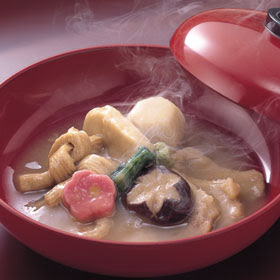
朱の椀の両手に温きじぶ煮かな
shu no wan no ryoote ni atataki jibuni kana
a red laquer bowl
keeps both my hands warm ...
aaa, this jibuni
Sakura Toshiko 桜敏子
*****************************
Related words
***** WASHOKU : Regional Japanese Dishes
lotus
***** . Folk Toys from Ishikawa Ishikawa Folk Art - 石川県 .
:::::::::::::::::::::::::::::::::::::::::::::::::::::::::::::::::::::::::::::::::::::::::::::::::::::::::::::::::::::::::::
[ . BACK to DARUMA MUSEUM TOP . ]
[ . BACK to WORLDKIGO . TOP . ]
:::::::::::::::::::::::::::::::::::::::::::::::::::::::::::::::::::::::::::::::::::::::::::::::::::::::::::::::::::::::::::
